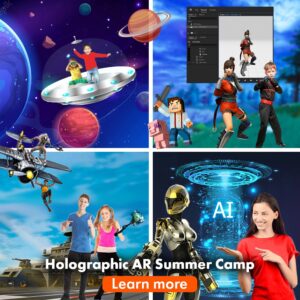
The “Mercury Exploration with AR & AI” project offers a hands-on, engaging way for students to learn about the smallest planet in our solar system, bringing Mercury’s unique characteristics into vivid focus. With just a computer and a projector, TV, or smart board, teachers can guide students through interactive experiences that explore Mercury’s orbit, cratered surface, and atmospheric differences from Earth. This free AR project is designed to spark curiosity and provide a concrete understanding of planetary science through simple yet effective visuals and AI-driven conversations.
Throughout this project, students will interact with key aspects of Mercury’s environment, from its rapid orbit around the Sun to its surface covered in impact craters. Each part of the project aligns with NGSS standards, allowing students to explore planetary science concepts through real-time discussions, simulations, and activities. In this guide, you’ll find structured instructions, pre- and post-project activities, and formative assessments to help make learning about Mercury both accessible and impactful. Download the project today to engage your students with Mercury’s fascinating characteristics and deepen their understanding of our solar system.
Instruction Guide
Introduction to the Project:
- Part 1: Meet Mercury – Introduce Mercury as the smallest planet and the closest to the Sun, engaging students with basic facts.
- Part 2: The Orbit Challenge – Explain Mercury’s unique orbit speed compared to Earth.
- Part 3: Mercury’s Surface – Focus on Mercury’s cratered surface and lack of atmosphere, relating it to gravitational forces.
- Part 4: Reflection Questions – Use discussion prompts to encourage understanding of atmospheric effects on planetary surfaces.
- Part 5: Conclusion – Summarize Mercury’s unique qualities and differences from Earth, fostering curiosity about other planets.
Each part involves engaging AR or AI conversations with students/teachers.
Learning Objectives and Outcomes
Learning Objectives with NGSS Standards Alignment:
- Understand Mercury’s Position, Size, and Lack of Atmosphere
- Objective: Students will identify Mercury as the closest planet to the Sun, describe its small size, and explore the consequences of its lack of atmosphere.
- NGSS Alignment: ESS1.B: Earth and the Solar System – Helps students understand Mercury’s characteristics within the solar system, including size, position, and atmospheric differences.
- NGSS Code: 5-ESS1-2 – Represent data about planetary characteristics, comparing Mercury’s lack of atmosphere and its effects on surface conditions to other planets.
- Analyze Mercury’s Orbit and Compare it to Earth’s
- Objective: Students will examine Mercury’s fast orbit around the Sun, compare it to Earth’s, and discuss how Mercury’s position impacts its orbital speed and year length.
- NGSS Alignment: ESS1.B: Earth and the Solar System – Introduces spatial relationships in planetary orbits, enabling students to observe patterns in orbit durations based on distance from the Sun.
- NGSS Code: 5-ESS1-2 – Explore and compare the duration of Mercury’s orbit to Earth’s, reinforcing understanding of time and spatial relationships in the solar system.
- Explore Cause and Effect by Examining Mercury’s Surface Craters
- Objective: Students will investigate how Mercury’s lack of atmosphere allows space rocks to impact its surface directly, creating numerous craters.
- NGSS Alignment: PS2.B: Types of Interactions – Focuses on the effects of gravitational and atmospheric interactions on planetary surfaces.
- NGSS Code: 5-PS2-1 – Support an argument that Mercury’s lack of atmosphere causes numerous craters due to the direct impact of space rocks, illustrating cause-and-effect relationships.
Learning Outcomes:
- Outcome 1: Students can summarize Mercury’s characteristics, including its position, size, and lack of atmosphere, using key scientific vocabulary.
- Outcome 2: Students can compare Mercury’s orbit and surface features to Earth’s, discussing differences in a meaningful way and presenting findings clearly.
- Outcome 3: Students engage in discussions about Mercury’s unique features, using scientific terminology aligned with NGSS and Common Core standards to describe Mercury’s orbit, atmosphere, and surface characteristics.
Classroom Activity Design
Pre-AR Project Activities (Warm-Up & Background Building)
- Planetary Comparison Warm-Up
- Objective: Introduce students to the idea of planetary differences.
- Activity: Using a simple table, students list what they know (or think they know) about Mercury, Earth, and the Moon. Focus on basic comparisons in size, location in the solar system, and surface characteristics (e.g., atmosphere, craters).
- Outcome: Builds background knowledge and curiosity, prompting students to ask questions that the AR experience can answer.
- Orbit Basics Discussion
- Objective: Prepare students for understanding Mercury’s rapid orbit.
- Activity: Briefly explain what an orbit is and compare Earth’s and Mercury’s distance from the Sun, discussing why Mercury might orbit faster. This can be illustrated with a simple model or video.
- Outcome: Provides context for understanding why Mercury orbits the Sun faster and helps students grasp time-based differences between planets.
Holographic AR Project: Mercury Exploration with AR & AI
- Guided Experience: Students participate in the interactive AR journey with AI prompts guiding them through key facts about Mercury’s size, orbit, surface, and lack of atmosphere.
- AI Interaction: During the AR experience, students engage with the AI, answering questions and observing simulations of Mercury’s movement, craters, and space rocks.
Post-AR Project Activities (Reinforcement & Hands-On Learning)
- Mercury Fact-Check Discussion
- Objective: Reinforce key takeaways from the AR experience.
- Activity: In small groups or as a class, students discuss what they learned about Mercury’s size, orbit, and surface. Each student shares a “new fact” and clarifies any remaining questions.
- Outcome: Encourages students to recall and articulate the main points from the AR experience, reinforcing comprehension through discussion.
- Crater Creation Activity (Hands-On)
- Objective: Help students visualize how Mercury’s craters form due to its lack of atmosphere.
- Activity: Using a tray of flour and small rocks, students drop the rocks from varying heights to simulate craters forming on Mercury’s surface. They observe the size and depth of craters, comparing results.
- Outcome: Provides a tangible demonstration of how impacts affect planetary surfaces, linking directly to Mercury’s cratered surface as observed in the AR experience.
- Orbit Visualization (Graphical Representation)
- Objective: Solidify understanding of Mercury’s fast orbit compared to Earth.
- Activity: Students use a simple graph or timeline to show Mercury’s 88-day orbit compared to Earth’s 365 days. They can also count the number of Mercury orbits in one Earth year.
- Outcome: Reinforces the concept of orbital speed differences and proportionality in a visual way, deepening understanding of Mercury’s position and movement relative to Earth.
Classroom Management Tips
- Clear Viewing: Arrange the classroom so all students have a clear view of the project screen or TV displaying the Holographic AR experience. This ensures everyone is engaged and can observe the interactions closely.
- Rotate Participation: Select different students to participate in each part of the AR project, allowing everyone a chance to engage. Be mindful of balancing participation so each student gets a turn to interact with the AI.
- Pre-Prepared Responses: Before the AR experience, guide students on potential answers for the AI conversation prompts. This can help students feel more confident and allows them to practice their responses, especially beneficial for shy students or those who may need extra thinking time.
- Inclusive Participation: Recognize that some students may be shy or need additional time to gather their thoughts. Make space for quieter students to participate by gently encouraging them and being patient as they respond.
- Positive Reinforcement: Praise each student who participates in the experience, reinforcing their engagement and contributions. Positive feedback encourages others to participate and builds confidence.
- Take Turns Fairly: Encourage fair turn-taking by organizing a rotation system or tracking turns to ensure all students have a chance to experience the AR interaction. For students who may want repeated turns, kindly remind them that everyone needs a fair chance to participate, ensuring inclusivity and shared learning.
Formative Assessments
- Quick Check: After each stage, ask students to share one key fact they learned.
- Reflection Journal: Students write a brief entry after each activity, summarizing Mercury’s characteristics.
- Orbit Data Sheet: Students complete a worksheet comparing Mercury’s orbit with Earth’s, demonstrating comprehension.
- Surface Analysis Report: After the game, students create a short report on crater formation, citing reasons for Mercury’s surface structure.
Formative Assessments: Detailed Teacher Guide
Purpose of Formative Assessments: These assessments help gauge students’ understanding during the lesson and provide insight into their grasp of key concepts like planetary orbits, surface features, and comparisons. These activities are low-stakes, designed to reinforce the AR experience without intimidating students.
1. Orbit Comparison Activity Sheet
Objective: Help students understand the difference in orbit speeds and durations between Mercury and Earth.
Instructions for Teachers:
- Distribute a one-page worksheet that visually compares Earth’s and Mercury’s orbits.
- Use simple language and graphics to guide students through the comparison, making the activity approachable and fun.
Example Questions:
- “How many Earth days make up one Mercury year?” – (Answer: 88 days)
- “How many days are in one Earth year?” – (Answer: 365 days)
- “Circle which planet orbits the Sun faster: Mercury or Earth?” – Give students a choice to circle the correct answer.
- “Draw a line from each planet to show how many days its orbit takes.” – This visual matching activity can help students understand relative timeframes (e.g., connect “88 days” to Mercury and “365 days” to Earth).
Teacher Tip: Encourage students to think about why Mercury’s year is shorter, linking it back to the AR experience where they learned Mercury orbits closer to the Sun.
2. Surface Reflection Sheet
Objective: Reinforce the concept of crater formation on Mercury due to its lack of atmosphere and encourage students to relate this to Earth.
Instructions for Teachers:
- After the AR experience, give each student a worksheet with short prompts for writing or drawing about Mercury’s surface.
- This worksheet allows students to reflect on why Mercury has so many craters, reinforcing their understanding in a fun, hands-on way.
Example Prompts:
- “Why does Mercury have so many craters?” – Guide students to respond in simple terms, such as, “Mercury has craters because it has no atmosphere to stop space rocks.”
- “Draw Mercury with craters on its surface.” – Encourage students to draw a picture showing Mercury with craters, as a visual representation of what they learned.
- “If Earth didn’t have an atmosphere, what would happen to its surface?” – Give students space to think creatively and explain their ideas, such as, “Earth would have more craters, like Mercury.”
Teacher Tip: If some students struggle with writing, allow them to share verbally or focus on the drawing prompt to express their understanding.
- Reflection Journal: Detailed Guide for Teachers
Purpose of the Reflection Journal: This activity gives students a dedicated space to write brief reflections, helping them process and summarize key information about Mercury. Each entry focuses on essential facts from the AR experience, promoting retention and understanding in an age-appropriate way.
How to Use the Reflection Journal
- Setting Up: Provide each student with a small notebook or journal dedicated to reflections. Alternatively, you could provide a printed template with prompts and space to write.
- Frequency: Encourage students to make a journal entry after each part of the AR experience, using prompts to guide their thoughts.
- Format: The entries should be short and simple. Younger students may write 1-2 sentences, while older elementary students can write a short paragraph. Drawings can also be used to help express understanding.
Example Prompts by Stage
Stage 1: Meet Mercury
- Prompt: “Describe one interesting fact about Mercury’s size or position in the solar system.”
- Sample Entry: “Mercury is the smallest planet and closest to the Sun. It’s even smaller than Earth but a little bigger than the Moon.”
Stage 2: The Orbit Challenge
- Prompt: “Explain why Mercury orbits the Sun faster than Earth.”
- Sample Entry: “Mercury’s orbit around the Sun only takes 88 days because it’s closer to the Sun than Earth. If I lived there, I’d have 4 birthdays every Earth year!”
Stage 3: Mercury’s Surface
- Prompt: “Why does Mercury have so many craters, and how does this compare to Earth?”
- Sample Entry: “Mercury has lots of craters because it doesn’t have an atmosphere to protect it from space rocks. On Earth, rocks mostly burn up in the atmosphere before hitting the ground.”
Stage 4: Reflection Questions
- Prompt: “Write about something new you learned today that surprised you about Mercury or Earth.”
- Sample Entry: “I learned that Earth has fewer craters than Mercury because our atmosphere protects us. Without it, we’d have craters everywhere too!”
Stage 5: Conclusion
- Prompt: “Summarize what makes Mercury different from Earth.”
- Sample Entry: “Mercury is smaller, orbits faster, and has no atmosphere, so it’s covered in craters. Earth is bigger, has an atmosphere, and fewer craters.”
Additional Tips for Teachers
- Encourage Creativity: Allow students to draw along with their written responses if they feel more comfortable expressing ideas visually.
- Keep It Low-Pressure: Let students write freely without focusing on spelling or grammar perfection. The goal is to capture their understanding.
- Praise Effort: Recognize students’ efforts and insights in their reflections, reinforcing their engagement and curiosity.
The Reflection Journal helps students solidify what they’ve learned in their own words, making it a valuable tool for both comprehension and confidence-building.
Cross-Subject Integration Suggestions
- Math: Graphing Mercury’s orbit data and calculating proportional relationships in time (Earth vs. Mercury years).
- Art: Have students create a visual representation of Mercury’s surface based on crater data.
- Language Arts: Summarize findings in structured paragraphs, using vocabulary words (e.g., “craters,” “atmosphere,” “orbit”).
- History/Social Studies: Discuss how Mercury was discovered and the history of its exploration.




Recent Comments